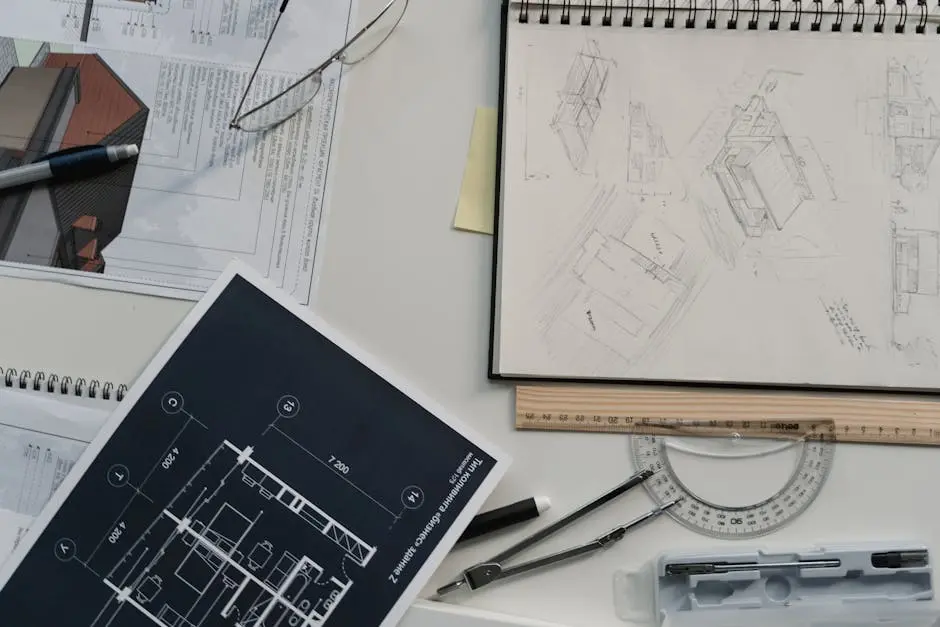Exploring the Latest Trends in Design Services


Design Services
Sep 14, 2024
In today's fast-paced world, design services are evolving at an unprecedented pace. This blog aims to explore the latest trends that are shaping the industry, from sustainable design practices to the integration of advanced technology. We will take a closer look at how these trends are influencing not just the way design services operate but also the expectations clients have in an increasingly competitive market.

The Rise of Sustainable Design Practices
In recent years, the design services industry has witnessed a significant shift towards sustainability. Designers are more conscious than ever of the environmental impact of their choices. This surge in sustainability isn't just a trend; it's becoming a core value for clients who seek eco-friendly solutions. As awareness about climate change and sustainability continues to grow, the demand for design services that prioritize environmentally friendly materials and processes has skyrocketed.
Sustainable design practices not only reduce waste but can often enhance aesthetic appeal. For instance, using reclaimed wood or recycled materials can add unique character to a project, setting it apart from the rest. Furthermore, many designers are exploring biophilic design, which connects occupants with nature through the use of natural light, plant life, and organic materials. This integration fosters a sense of well-being, making it a compelling selling point for clients looking to invest in design services.
Additionally, eco-conscious branding is rising as businesses realize the marketing potential of sustainability. A thoughtfully designed space that incorporates sustainable elements can enhance a brand's image and attract environmentally minded consumers. The ripple effect of sustainable design practices goes beyond aesthetics—it reshapes how we view and interact with our environment.
Embracing Technology in Design Services
Technology is transforming design services in ways we could only imagine a decade ago. One standout trend is the use of augmented reality (AR) and virtual reality (VR). These technologies allow clients to step into their projects before they are built, making it easier to visualize completed designs. This not only streamlines the decision-making process but also enhances client satisfaction by enabling more informed choices.
Moreover, Artificial Intelligence (AI) is making significant inroads into design. AI tools can generate design options based on specified criteria, enabling designers to experiment with diverse styles and layouts quickly. This integration accelerates the creative process, allowing professionals to focus on the more nuanced aspects of their work, such as client communication and fine-tuning design details.
Additionally, cloud-based design platforms are making collaboration easier across teams located in different parts of the world. Embracing these technologies indicates a shift towards a more connected and innovative design landscape. As designers leverage these advanced tools, they can produce higher-quality work faster, ultimately enhancing the overall effectiveness of design services.
The continuous development of technology also highlights the importance of lifelong learning among design professionals. By staying updated with the latest design software and tools, designers can ensure they remain competitive and relevant in a rapidly changing industry.
User-Centered Design and Its Importance
At the heart of modern design services is user-centered design. This approach places the end-user at the center of the design process, ensuring that their needs, preferences, and experiences shape the final product. In an era where customer experiences are paramount, this trend signifies a shift towards more empathetic and effective design.
Engaging with users to gather feedback and insights throughout the design process leads to more tailored solutions. Designers who invest time in understanding user behavior and preferences can create more compelling and functional designs. This iterative approach often results in a final product that resonates deeply with users, ultimately elevating their satisfaction and engagement.
Furthermore, user-centered design not only applies to graphic and product design but also finds its way into service design and UX/UI design. The emphasis on creating an intuitive user experience makes it integral for any design project aiming to be successful. As a result, collaboration between designers and end-users is becoming not just beneficial, but essential to the practice.
The Impact of Remote Collaboration Tools
The recent global shift toward remote work has significantly influenced how design services are conducted. With the rise of remote collaboration tools, teams can now work together seamlessly, regardless of their physical locations. These tools not only foster communication but also offer features that enhance productivity and creativity.
Platforms that facilitate real-time collaboration, such as Figma or Miro, have become indispensable for design teams. They allow designers to brainstorm, share ideas, and make edits on-the-fly, all while ensuring everyone is on the same page. Such capabilities eliminate the obstacles that traditionally hindered remote collaboration, resulting in more efficient workflows.
Moreover, remote collaboration tools promote diversity and inclusion within design teams. By breaking down geographical barriers, talented individuals from various backgrounds can contribute to the design process. This diversity enriches the creative output, leading to innovative solutions that reflect a wider range of perspectives and experiences.
Trends in Typography and Color Schemes
As design services evolve, so too do the trends in typography and color schemes. In recent years, minimalist design has emerged as a prominent choice, emphasizing clean lines and simple typography. This aesthetic appeals to modern sensibilities and ensures readability across various platforms, a crucial element in today's digital landscape.
Color schemes are enjoying a renaissance as well, with designers increasingly favoring bold and unexpected combinations. The traditional use of muted tones is giving way to vibrant palettes that make statements and evoke emotions. This shift encourages designers to experiment and push creative boundaries, fostering a more engaging visual landscape for audiences.
Furthermore, the principle of accessibility drives many typography choices. Designers are now prioritizing legibility, ensuring that typefaces are not only stylish but also easily readable for everyone, including those with visual impairments. This emphasis on inclusivity reflects a broader trend in design services towards creating experiences that cater to diverse audiences.
The Future of Graphic Design Services
Looking ahead, the future of graphic design services appears both exciting and challenging. With the rapid pace of technological advancements, designers must continually adapt to emerging tools and trends. This landscape offers endless opportunities for creativity, but also requires a commitment to lifelong learning and experimentation.
Moreover, as client expectations rise, the demand for hyper-personalized design experiences is likely to grow. Clients will increasingly seek solutions that reflect their unique identities and values. This trend underlines the importance of understanding client needs and maintaining a flexible approach to design, ensuring that services evolve in line with this growing demand.
Ultimately, the future of design services is intertwined with the evolving nature of communication, technology, and consumer behavior. By staying at the forefront of these changes and leveraging new opportunities, designers can continue to innovate and create impactful work that resonates in an ever-changing world.
Navigating the Future of Design Services
As we navigate through the changing landscape of design services, it becomes clear that staying updated with the latest trends is essential for success. Embracing new technologies, prioritizing sustainability, and focusing on user experience are just a few ways that designers can remain relevant in this dynamic environment. By understanding and adapting to these trends, design professionals can offer clients innovative solutions that meet modern demands.




Design Services
Sep 14, 2024
In today's fast-paced world, design services are evolving at an unprecedented pace. This blog aims to explore the latest trends that are shaping the industry, from sustainable design practices to the integration of advanced technology. We will take a closer look at how these trends are influencing not just the way design services operate but also the expectations clients have in an increasingly competitive market.

The Rise of Sustainable Design Practices
In recent years, the design services industry has witnessed a significant shift towards sustainability. Designers are more conscious than ever of the environmental impact of their choices. This surge in sustainability isn't just a trend; it's becoming a core value for clients who seek eco-friendly solutions. As awareness about climate change and sustainability continues to grow, the demand for design services that prioritize environmentally friendly materials and processes has skyrocketed.
Sustainable design practices not only reduce waste but can often enhance aesthetic appeal. For instance, using reclaimed wood or recycled materials can add unique character to a project, setting it apart from the rest. Furthermore, many designers are exploring biophilic design, which connects occupants with nature through the use of natural light, plant life, and organic materials. This integration fosters a sense of well-being, making it a compelling selling point for clients looking to invest in design services.
Additionally, eco-conscious branding is rising as businesses realize the marketing potential of sustainability. A thoughtfully designed space that incorporates sustainable elements can enhance a brand's image and attract environmentally minded consumers. The ripple effect of sustainable design practices goes beyond aesthetics—it reshapes how we view and interact with our environment.
Embracing Technology in Design Services
Technology is transforming design services in ways we could only imagine a decade ago. One standout trend is the use of augmented reality (AR) and virtual reality (VR). These technologies allow clients to step into their projects before they are built, making it easier to visualize completed designs. This not only streamlines the decision-making process but also enhances client satisfaction by enabling more informed choices.
Moreover, Artificial Intelligence (AI) is making significant inroads into design. AI tools can generate design options based on specified criteria, enabling designers to experiment with diverse styles and layouts quickly. This integration accelerates the creative process, allowing professionals to focus on the more nuanced aspects of their work, such as client communication and fine-tuning design details.
Additionally, cloud-based design platforms are making collaboration easier across teams located in different parts of the world. Embracing these technologies indicates a shift towards a more connected and innovative design landscape. As designers leverage these advanced tools, they can produce higher-quality work faster, ultimately enhancing the overall effectiveness of design services.
The continuous development of technology also highlights the importance of lifelong learning among design professionals. By staying updated with the latest design software and tools, designers can ensure they remain competitive and relevant in a rapidly changing industry.
User-Centered Design and Its Importance
At the heart of modern design services is user-centered design. This approach places the end-user at the center of the design process, ensuring that their needs, preferences, and experiences shape the final product. In an era where customer experiences are paramount, this trend signifies a shift towards more empathetic and effective design.
Engaging with users to gather feedback and insights throughout the design process leads to more tailored solutions. Designers who invest time in understanding user behavior and preferences can create more compelling and functional designs. This iterative approach often results in a final product that resonates deeply with users, ultimately elevating their satisfaction and engagement.
Furthermore, user-centered design not only applies to graphic and product design but also finds its way into service design and UX/UI design. The emphasis on creating an intuitive user experience makes it integral for any design project aiming to be successful. As a result, collaboration between designers and end-users is becoming not just beneficial, but essential to the practice.
The Impact of Remote Collaboration Tools
The recent global shift toward remote work has significantly influenced how design services are conducted. With the rise of remote collaboration tools, teams can now work together seamlessly, regardless of their physical locations. These tools not only foster communication but also offer features that enhance productivity and creativity.
Platforms that facilitate real-time collaboration, such as Figma or Miro, have become indispensable for design teams. They allow designers to brainstorm, share ideas, and make edits on-the-fly, all while ensuring everyone is on the same page. Such capabilities eliminate the obstacles that traditionally hindered remote collaboration, resulting in more efficient workflows.
Moreover, remote collaboration tools promote diversity and inclusion within design teams. By breaking down geographical barriers, talented individuals from various backgrounds can contribute to the design process. This diversity enriches the creative output, leading to innovative solutions that reflect a wider range of perspectives and experiences.
Trends in Typography and Color Schemes
As design services evolve, so too do the trends in typography and color schemes. In recent years, minimalist design has emerged as a prominent choice, emphasizing clean lines and simple typography. This aesthetic appeals to modern sensibilities and ensures readability across various platforms, a crucial element in today's digital landscape.
Color schemes are enjoying a renaissance as well, with designers increasingly favoring bold and unexpected combinations. The traditional use of muted tones is giving way to vibrant palettes that make statements and evoke emotions. This shift encourages designers to experiment and push creative boundaries, fostering a more engaging visual landscape for audiences.
Furthermore, the principle of accessibility drives many typography choices. Designers are now prioritizing legibility, ensuring that typefaces are not only stylish but also easily readable for everyone, including those with visual impairments. This emphasis on inclusivity reflects a broader trend in design services towards creating experiences that cater to diverse audiences.
The Future of Graphic Design Services
Looking ahead, the future of graphic design services appears both exciting and challenging. With the rapid pace of technological advancements, designers must continually adapt to emerging tools and trends. This landscape offers endless opportunities for creativity, but also requires a commitment to lifelong learning and experimentation.
Moreover, as client expectations rise, the demand for hyper-personalized design experiences is likely to grow. Clients will increasingly seek solutions that reflect their unique identities and values. This trend underlines the importance of understanding client needs and maintaining a flexible approach to design, ensuring that services evolve in line with this growing demand.
Ultimately, the future of design services is intertwined with the evolving nature of communication, technology, and consumer behavior. By staying at the forefront of these changes and leveraging new opportunities, designers can continue to innovate and create impactful work that resonates in an ever-changing world.
Navigating the Future of Design Services
As we navigate through the changing landscape of design services, it becomes clear that staying updated with the latest trends is essential for success. Embracing new technologies, prioritizing sustainability, and focusing on user experience are just a few ways that designers can remain relevant in this dynamic environment. By understanding and adapting to these trends, design professionals can offer clients innovative solutions that meet modern demands.
View More



Design Services
Sep 14, 2024
In today's fast-paced world, design services are evolving at an unprecedented pace. This blog aims to explore the latest trends that are shaping the industry, from sustainable design practices to the integration of advanced technology. We will take a closer look at how these trends are influencing not just the way design services operate but also the expectations clients have in an increasingly competitive market.

The Rise of Sustainable Design Practices
In recent years, the design services industry has witnessed a significant shift towards sustainability. Designers are more conscious than ever of the environmental impact of their choices. This surge in sustainability isn't just a trend; it's becoming a core value for clients who seek eco-friendly solutions. As awareness about climate change and sustainability continues to grow, the demand for design services that prioritize environmentally friendly materials and processes has skyrocketed.
Sustainable design practices not only reduce waste but can often enhance aesthetic appeal. For instance, using reclaimed wood or recycled materials can add unique character to a project, setting it apart from the rest. Furthermore, many designers are exploring biophilic design, which connects occupants with nature through the use of natural light, plant life, and organic materials. This integration fosters a sense of well-being, making it a compelling selling point for clients looking to invest in design services.
Additionally, eco-conscious branding is rising as businesses realize the marketing potential of sustainability. A thoughtfully designed space that incorporates sustainable elements can enhance a brand's image and attract environmentally minded consumers. The ripple effect of sustainable design practices goes beyond aesthetics—it reshapes how we view and interact with our environment.
Embracing Technology in Design Services
Technology is transforming design services in ways we could only imagine a decade ago. One standout trend is the use of augmented reality (AR) and virtual reality (VR). These technologies allow clients to step into their projects before they are built, making it easier to visualize completed designs. This not only streamlines the decision-making process but also enhances client satisfaction by enabling more informed choices.
Moreover, Artificial Intelligence (AI) is making significant inroads into design. AI tools can generate design options based on specified criteria, enabling designers to experiment with diverse styles and layouts quickly. This integration accelerates the creative process, allowing professionals to focus on the more nuanced aspects of their work, such as client communication and fine-tuning design details.
Additionally, cloud-based design platforms are making collaboration easier across teams located in different parts of the world. Embracing these technologies indicates a shift towards a more connected and innovative design landscape. As designers leverage these advanced tools, they can produce higher-quality work faster, ultimately enhancing the overall effectiveness of design services.
The continuous development of technology also highlights the importance of lifelong learning among design professionals. By staying updated with the latest design software and tools, designers can ensure they remain competitive and relevant in a rapidly changing industry.
User-Centered Design and Its Importance
At the heart of modern design services is user-centered design. This approach places the end-user at the center of the design process, ensuring that their needs, preferences, and experiences shape the final product. In an era where customer experiences are paramount, this trend signifies a shift towards more empathetic and effective design.
Engaging with users to gather feedback and insights throughout the design process leads to more tailored solutions. Designers who invest time in understanding user behavior and preferences can create more compelling and functional designs. This iterative approach often results in a final product that resonates deeply with users, ultimately elevating their satisfaction and engagement.
Furthermore, user-centered design not only applies to graphic and product design but also finds its way into service design and UX/UI design. The emphasis on creating an intuitive user experience makes it integral for any design project aiming to be successful. As a result, collaboration between designers and end-users is becoming not just beneficial, but essential to the practice.
The Impact of Remote Collaboration Tools
The recent global shift toward remote work has significantly influenced how design services are conducted. With the rise of remote collaboration tools, teams can now work together seamlessly, regardless of their physical locations. These tools not only foster communication but also offer features that enhance productivity and creativity.
Platforms that facilitate real-time collaboration, such as Figma or Miro, have become indispensable for design teams. They allow designers to brainstorm, share ideas, and make edits on-the-fly, all while ensuring everyone is on the same page. Such capabilities eliminate the obstacles that traditionally hindered remote collaboration, resulting in more efficient workflows.
Moreover, remote collaboration tools promote diversity and inclusion within design teams. By breaking down geographical barriers, talented individuals from various backgrounds can contribute to the design process. This diversity enriches the creative output, leading to innovative solutions that reflect a wider range of perspectives and experiences.
Trends in Typography and Color Schemes
As design services evolve, so too do the trends in typography and color schemes. In recent years, minimalist design has emerged as a prominent choice, emphasizing clean lines and simple typography. This aesthetic appeals to modern sensibilities and ensures readability across various platforms, a crucial element in today's digital landscape.
Color schemes are enjoying a renaissance as well, with designers increasingly favoring bold and unexpected combinations. The traditional use of muted tones is giving way to vibrant palettes that make statements and evoke emotions. This shift encourages designers to experiment and push creative boundaries, fostering a more engaging visual landscape for audiences.
Furthermore, the principle of accessibility drives many typography choices. Designers are now prioritizing legibility, ensuring that typefaces are not only stylish but also easily readable for everyone, including those with visual impairments. This emphasis on inclusivity reflects a broader trend in design services towards creating experiences that cater to diverse audiences.
The Future of Graphic Design Services
Looking ahead, the future of graphic design services appears both exciting and challenging. With the rapid pace of technological advancements, designers must continually adapt to emerging tools and trends. This landscape offers endless opportunities for creativity, but also requires a commitment to lifelong learning and experimentation.
Moreover, as client expectations rise, the demand for hyper-personalized design experiences is likely to grow. Clients will increasingly seek solutions that reflect their unique identities and values. This trend underlines the importance of understanding client needs and maintaining a flexible approach to design, ensuring that services evolve in line with this growing demand.
Ultimately, the future of design services is intertwined with the evolving nature of communication, technology, and consumer behavior. By staying at the forefront of these changes and leveraging new opportunities, designers can continue to innovate and create impactful work that resonates in an ever-changing world.
Navigating the Future of Design Services
As we navigate through the changing landscape of design services, it becomes clear that staying updated with the latest trends is essential for success. Embracing new technologies, prioritizing sustainability, and focusing on user experience are just a few ways that designers can remain relevant in this dynamic environment. By understanding and adapting to these trends, design professionals can offer clients innovative solutions that meet modern demands.




